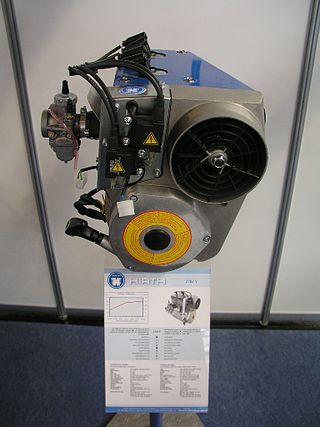Development

Very closely based upon the Norton engine, the MidWest engine developed the design further. The lubrication system became a semi-total-loss system whereby Silkolene 2-stroke oil was directly injected into the inlet tracts and onto the main roller bearings, but the oil that fed the bearings became an oil-mist within the rotor-cooling air, with about 30% [4] of the oil recovered and returned to the remote oil tank. Unlike the Norton engine, the rotor-cooling air was forced in by a belt-driven centrifugal pump and then dumped overboard as it was considered too hot for ideal volumetric efficiency. Instead, ambient-temperature combustion air was inducted into the engine separately. Early Midwest engines had simple Tillotson carburettors, but these proved unsatisfactory and later engines were fitted with fuel injection. [5] This gave the advantage both of precise fuel delivery and avoided the need for carburettor heat as the risk of induction icing was diminished.
The engine produces maximum power at 7,500 rpm (the rotors turning at only 2,500 rpm), a 2.96:1 reduction gearbox (closely based on that in the Hewland AE75 engine) gave an efficient maximum propeller speed 2,500 rpm. [6] Unlike the Hewland's gearbox, where the output shaft and propeller flange were below the crankshaft, the MidWest's gearbox had its output shaft higher than the eccentric shaft. When installed in the ARV Super2 aircraft, this feature allowed a larger diameter propeller to be used, with better propeller clearance, while raising the height of the engine's thrust line, and reducing downward visibility over the nose very slightly.
Marketing
MidWest planned to market the AE-series engine in the fast-growing light aircraft and kitplane sector. The AE engine's characteristics made it suited for aviation use, being lightweight, very compact, low vibration and simple in construction. Also, whereas Wankel engines in car and motorcycle applications often suffered insufficient engine warm up time prior to power application, in aircraft use, engine checks and taxiing ensured that it would be at operating temperature by the time the runway was reached. However, two factors lead to the MidWest engine's lack of market success downfall. The engine was originally intended to be the main powerplant for the Europa XS, but the kitplane's designer, Ivan Shaw, lost patience with the crude Tillotson carburettors, and opted for the Rotax 912 as a replacement. Instead of initially making their engines available only for non-certified aircraft, MidWest embarked on the expensive and time-consuming process of seeking a type certificate and the engine ceased production after only a limited number had been built. [7]





